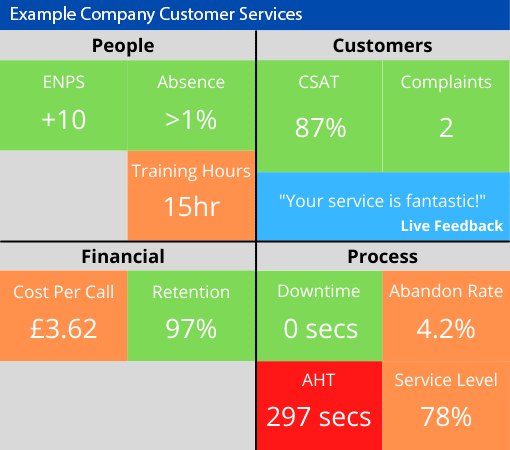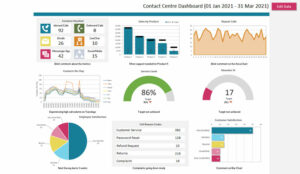A balanced customer scorecard is one of the most effective tools for aligning contact centre performance with business strategy.
By combining qualitative and quantitative metrics across several performance areas, it helps managers monitor progress, identify issues, and drive strategic improvement, all while engaging frontline teams.
In this article, we’ll define what a balanced scorecard is, walk through how to build and use a customer scorecard, highlight key pitfalls, and offer a free downloadable template to help you get started.
What Is a Balanced Customer Scorecard?
A balanced scorecard breaks down an organization’s strategy into four “perspectives”.
Typically, these are:
- People
- Customers
- Financial
- Process
The organization would then set objectives and targets against each of the four sections, to bring their strategy to life:
Different departments within the business – including the contact centre – then set metrics and benchmarks for how they will measure their performance, in respect to these organizational objectives.
In doing so, the contact centre will break its metrics and benchmarks down across the four perspectives, to keep a close eye on the “bigger picture”.
The key benefit of a balanced scorecard is that each department considers performance in terms of the wider organizational strategy.
Targets can then be clearly defined, while the contact centre can then focus on aligning their data sources to automate the subsequent reporting process.
Four Steps to Build a Scorecard
The following steps should be considered when putting together a scorecard:
Step 1 – Decide Where to Start
If the balanced scorecard is an organization-wide initiative, most of the legwork is already done. The contact centre can simply skip ahead to choosing the right metrics.
However, when an organization does not break its strategy down into the four categories, the contact centre may want to create a unique scorecard that considers more general objectives.
The upside to this is that contact centres don’t have to stick to the four traditional perspectives of the balanced scorecard. They can choose their own approach.
For example, Martin Jukes, Managing Director of Mpathy Plus, often encourages contact centres to divide their scorecards into the following four perspectives:
- Demand by Channel
- Resource Availability
- Performance Outcomes
- Quality Outcomes
Yet, Martin recommends: “First consider: what is it that you’re trying to achieve? Then, use the balanced scorecard to weigh up your priorities. This will then become a tool that enables the management team to improve performance accordingly.”
For many contact centre leaders, the format that Martin presents will align much better with their way of working.
Just make sure that executives understand the purpose and importance of each category, as well as how they relate to wider business objectives.
Step 2 – Align With Corporate Strategy
By doing aligning the scorecard with corporate strategy, the contact centre ensures that information is managed in an accurate, consistent and timely manner.
Also, contact centres can clearly refocus their strategy on incremental performance improvements, which can be later be refined.
Finally, with a good, consistent scorecard, contact centres can easily spot when things are not performing as they usually do. This is particularly true if the scorecard incorporates data visualization techniques, such as a traffic light system.
Discover the fundamentals of call centre reporting in our article: A Quick Guide to Call Centre Reporting – With the Top Seven Reports, Examples and Tips
Step 3 – Choose the Right Metrics or KPIs
“In a service environment, there has historically been a drive to resolve the issue rather than understand the problem. That can often misdirect our metric focus,” says Martin.
However, with the balanced scorecard, companies can concentrate on the “big picture”, while increasing their knowledge of how different metrics influence one another.
The original idea, in fact, was to include a similar number of KPIs across the four sections of the scorecard. This meant that management would pay equal attention to each subset of metrics.
| Our People | Our Customers | Our Finances | Our Processes |
|---|---|---|---|
| Advisor Satisfaction | First Call Resolution | Cost per Contact | Downtime |
| Employee NPS | Customer Satisfaction | Customer Acquisition | Issue Logs |
| Attrition Rates | Net Promoter Score | Customer Retention | Escalation Times |
| Absences Rates | Customer Effort Score | Operating Expenses | Call Abandon Rates |
| Hours Spent on Training | Average Speed of Answer | Revenue per Successful Call | Average Handling Time |
| Talent Progression | Complaint Volumes | Overhead Costs | Service Level |
The key, however, is to select metrics that provide actionable results. Don’t just measure a metric because everyone else does, otherwise reporting simply becomes an exercise in wasting time.
Instead, use that time to understand every scorecard KPI in terms of its impact on the customer, employees and the wider business, as well as what it means when the metric increases/decreases in value.
If a contact centre manages to do so and feeds metric results through in real time, managers can be alert to potential problems and take action to solve them. This is excellent intraday management.
Over time, contact centres will learn corrective actions to better manage performance. Ideally, these will be written down as Standard Operating Procedures (SOPs). This enables more proactive contact centre management.
Tip – Start With a Handful of Metrics
A big part of managing metrics is not getting drowned in lots of information. First and foremost, stay focused on the key priorities.
So, when choosing KPIs for a balanced scorecard, start small and build from there.
“I’ve seen balanced scorecards start quite small and gradually, over a period of time, they grow and grow, with lots of extra details in them,” says Martin.
“Because they can grow like this, keep things simple – but informative – to begin with. The best reports are often just one page, which visualizes data with colours, charts and graphs.”
This last point is important because how these metrics are brought to life is the key to creating an informative, actionable scorecard…
Step 4 – Decide How to Present Your Balanced Scorecard
The best balanced scorecards show the viewer all of the information in one quick glance. They do so through effective data visualization techniques.
So, bring on the charts, graphs and – arguably the most effective system – a simple traffic light colour scheme. The latter is great for providing clear and immediate insight into the current status of performance.
“Create a dashboard that shows how things are changing. Indicate what the contact centre was expecting and how things were different from what they were expecting,” says Martin.
For this to work, contact centres set benchmarks with respect to what constitutes healthy performance.
When a contact centre hits such a benchmark, the metric on the dashboard will turn green. Amber is for when the contact centre is close to it, and red means that performance is well below par.
Here’s a mock-up of a balanced scorecard example to better illuminate the idea:

The ability to create such a scorecard in real time will not only hinge on the reporting tools that you have available but the supply of data too.
Integrating different systems – especially the CRM and dialler systems – so that data is exported to one common database is the ultimate aim. Yet, for many, this is a tricky prospect.
For some organizations, it can take a day to create a weekly report, just because the data access is so poor. They will also more than likely be using Excel for formatting, which can make it a cumbersome task.
Printable – Customer Scorecard Template
Do you want to download this to get started?
Get your free download of our free Excel Contact Centre Dashboard Template now:
Common Pitfalls to Avoid When Creating a Balanced Scorecard
There are also a few things you should be aware of when putting your scorecard together. To help we’ve put together a few of the top pitfalls you should avoid:
1. “Watermelon Metrics”
One of the key issues with balanced scorecards is that the KPIs can easily be tampered with. This means that contact centres, as well as other departments, can mislead executives as to their actual performance.
“I once worked with a company that set a target for average handling time (AHT),” says Nathan Dring, Principal Consultant at PA Consulting.
The nightshift leader, when everyone was gone, would use his mobile phone to ring and hang up, ring and hang up, ring and hang up and so on.
Suddenly, there were 100 calls answered in half a second, so AHT plummeted and, by the end of the day, the average was ‘in the green’.”
This is a classic example of a “watermelon metric”. Everything on the outside may appear green but, once the surface is scratched, the reality appears to be red.
Watch the video below where Sarah Morgan, Luceat Consulting, explores the concept of Watermelon Metrics and why contact centres need to be mindful of the metrics they use:
2. Trade-Off Blindness
Nathan encourages us to consider the trade-offs within a balanced scorecard.
For example, don’t expect to decrease handling and wait times while focusing on customer metrics such as customer satisfaction (CSAT), Net Promoter Score (NPS) and First Contact Resolution (FCR). The two types of goal directly oppose one another.
Failing to make considerations like this is a mistake. Although this is not the only trap to look out for.
3. Overly Complex Scorecards
As contact centres receive new objectives from the wider organization, the size of the balanced scorecard can grow. This is something that needs to be actively managed.
When a balanced scorecard starts to cover too many areas, it is a task to maintain it – especially if a contact centre’s technology is not sophisticated enough.
Also, as Nathan points out: “If your balanced scorecard is overloaded, it can be difficult to change behaviours, as there are too many metrics to focus on.”
4. Misunderstanding From Non-Contact Centre Staff
Too often, non-contact centre people try to understand and dictate a contact centre’s metric mix.
There is a danger here. For example, an executive may see ten calls lasting six minutes every hour and assume that only one advisor is needed, whereas we contact centre people know better than that.
So, point out the difference between strategic and operational measurements and, when targets are missed, include descriptions of factors that caused the issue. This will prevent others from drawing the wrong conclusions.
Is a Balanced Customer Scorecard Really the Best Option?
With all of these drawbacks, it is only natural to think: is a balanced scorecard really worth it?
Much of the time, this is a requirement from those who sit above the contact centre director but, if it is left down to the contact centre, really weigh up the advantages and disadvantages.
| Pro | Con |
|---|---|
| Aligns with organizational priorities | Things can become overly complex |
| Targets can be clearly defined | Easy to misunderstand metric relationships |
| The reporting process can largely be automated | People may misunderstand what metrics mean |
| Easy to spot irregular performance | Difficult to create the necessary flow of data |
Larger contact centres that can afford to automate much of the process may opt to press ahead with a balanced scorecard, as they can create a nice, consistent process for managing their metrics.
However, for smaller contact centres, which are working from Excel and hold little easy-to-access data, simply tracking a small set of metrics might be a better strategy.
While this may lack the complexity of a balanced scorecard, these contact centres can still home in on the metrics that matter most.
For more articles on improving contact centre strategy, check out the following:
- The Top Ten Customer Service Strategies That Stand the Test of Time
- 5 Contact Centre Improvement Strategies
- 50 Tips to Improve Your Service Strategy
Author: Charlie Mitchell
Reviewed by: Jonty Pearce
Published On: 8th Sep 2021 - Last modified: 6th Oct 2025
Read more about - Customer Service Strategy, Charlie Mitchell, Editor's Picks, Free Downloads, Key Performance Indicators (KPIs), Martin Jukes, Metrics, Nathan Dring, Sarah Morgan, Scorecards, Service Strategy





















